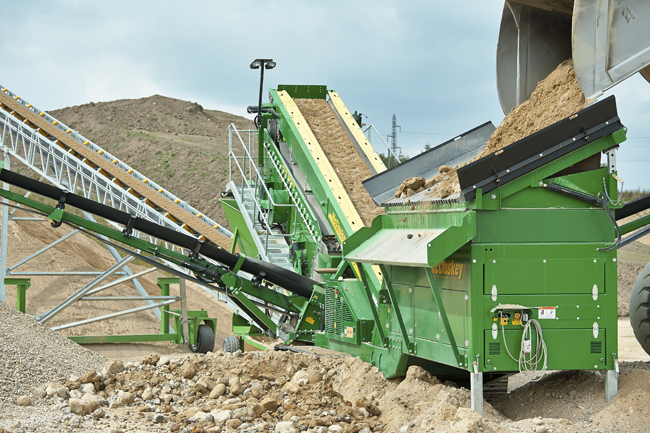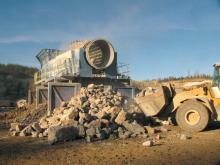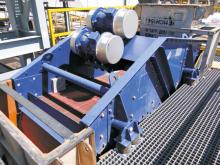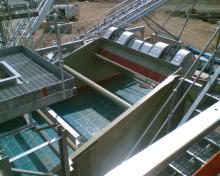
The last important production step in aggregates production is screening (classifying), which has to ensure high-quality screening curves of end products in accordance with standards. It is imperative that the process is executed in the most efficient manner. Munesu Shoko reports.
In the aggregates world, selling prices are often fixed and very competitive, and efficient screening is, more often than not, the cheapest method of dropping the overall cost per tonne on a plant. This is according to Fernando Abelho, head of sales for Africa at
“Many operators will spend time and money in the acquisition of best crushing equipment, then look for cheap options for their screens – be it the screen itself or the screening media. For example, in a 100tonnes per hour plant, a correct screen or screening media could make a simple 2% difference,” says Abelho.
“In a five-day, seven-hour operation, that’s an additional 70tonnes (3,5 tipper trucks) of production per week. That’s an additional +/-14 extra loads a month for the same overheads and fixed costs! This will depend on the type and quality of media, with cheaper meshes requiring more changeouts, meaning more downtime and loss of production,” adds Abelho.
Commenting on the significance of efficient screening, Waylon Kukard, sales manager at
The same view is shared by Rasheel Sukdhoe, product manager of the McCloskey crushing, screening, stacking and washing range at HPE Africa, the South African dealer for McCloskey, who says that the screening process is the most important part of the aggregates production process. “Screens are a way to control quality and gradation of aggregate product. Prior to screening, the product might not have as much of a value, however after screening the value of the product will increase,” he says.
Abelho adds that inefficient screening may result in the final product being out of specification. “This can have huge financial implications, not only in production costs related to the need to rescreen or re-crush the material, but can also result in penalties and potential loss of sales,” says Abelho.
When talking about screening efficiency, it is important to understand what it is in the first place and how it’s measured. In technical terms, screening efficiency is described as the comparison of the undersize material carried over the screening media and discharged with the oversize product in contrast to the input amount of undersize that was initially fed into the screen.
“Screening efficiency is the degree of accuracy of which undersize material is passed through an opening. It is measured by the quality and grading of the screened material. The screen length will determine the efficiency of the screen,” explains Sukdhoe.
According to Kukard, screening efficiency is the classification of different products according to a grading curve of the specific application. Sampling of the different stockpiles will be taken and put through a sieving process to determine if there is undersize material in the oversize.
Abelho says, in simple terms, screening efficiency is used to describe how precise a screen is when separating a feed material of differently sized particles into different size groups. Material that is smaller than the given aperture is denoted as under-size, anything larger than the aperture is considered oversize.
“Often the size of the material that passes the aperture is referred to as the cut size. Part of the reasoning behind this is that the screen angle, material depth and other factors will influence the material that passes the aperture. To give an idea, a screen at an 18-degree angle with an aperture of 8mm may produce a cut size of 6mm (i.e. 95% of the material is -6mm).”
Abelho adds that screening efficiency is expressed as a percentage and denotes the percentage of undersize in the original feed that is separated by the screen at the given aperture. “A straightforward illustration would be taking a feed of 100 tonnes per hour and separating at a given aperture size. When doing a sizing analysis of your stockpiles afterwards, if 85 tonnes of your undersize material is stockpiled, and an additional 5 tonnes of undersize material is in the ‘oversize stockpile’, the screening efficiency would be calculated as (85÷90) x 100 = 94,45%,” explains Abelho.
Abelho says that, as a general rule, no screen is 100% efficient, and for all intents and purposes, a screen operating at 95% efficiency is often considered ‘perfect’. Most commercial specs will specify a range of over/undersized material that is allowed in the final product.
“Typically, these specifications offer up to 5-15% deviation on the sizing. This means your screening can in some cases be as low as 85% efficient, and still be commercially acceptable. Note that the product may be in specification, but this inefficiency may be costing money due to production shortfalls. Understanding the end-product requirements is therefore important.”
Lots of factors should be considered in order to achieve screening efficiency. According to Kukard, thickness of the bed depth of material running over the screen deck (overloading the deck) is one of the crucial factors, as well as screening media, moisture, angle of the screen deck, speed of the screen deck, amplitude of the screen and the wear of the screening media.
According to Abelho, when it comes to screening efficiency, there are often factors that are crucial to a specific site but not necessarily a factor on another site, so site information is critical to make a proper assessment.
“Calculating screening efficiency ‘by hand’ involves pages of formulas (and different methods), it also requires detailed information of the PSD (product size distribution) of the feed material. Modern programs such as
The smaller the aperture on your screening deck, the smaller the open area (the amount of open space in the screening media that allows product to fall through). “A screen that efficiently screens out a 100tonnes/hour of -40mm product may be too small to screen out 50tonnes/hour of a -6mm product. This is as a result of the 40mm aperture mesh which has roughly 70% open area versus 40% on a typical 6mm wire mesh,” explains Abelho.
Speaking about stroke (also referred to as throw) versus frequency of a screen, Abelho says most screens operate at a maximum G-force of up to about 5gs, with 4,6gs being a good industry average of the maximum G-force allowed on a screen to avoid it self-destructing. The amount of G-force is a combination of the stroke and frequency, so typically a high frequency screen will have a short stroke, and vice-versa.
“For larger aperture screening a longer stroke and lower frequency screen is more suitable. A longer stroke ensures there is less chance of pegging (material that gets stuck in the open aperture), while the lower frequency ensures a longer bearing life and gives the larger material a better opportunity to pass through the open aperture,” adds Abelho.
For smaller aperture screening, Abelho says a short stroke and high frequency is advisable. A short stroke ensures the material is lifted just enough to stratify (separate into layers of differently sized material). Since the opening (and open area) of the screen is so small, a high frequency offers substantially more opportunities for the particles to find an open hole.
When it comes to bed depth – the thickness of the layer of material on a screen deck –ideally a material bed depth at the discharge end of a screen should be a maximum of four times the aperture size of the screening media.
“Too much material (high bed depth) on a screen deck minimises the chances of undersize material finding an opening to fall through. Often relieving decks (a deck that’s used to limit the amount of material on the sizing deck) is used to lower the bed depth on screens,” says Abelho.
He adds that too little material could cause the material to bounce too high, often minimising the chances of it finding an open aperture, especially on fine screening.
When it comes to screening media, Abelho says the type of media that will be used is important to know, as different types of media offer different open area percentages. Without a good knowledge of the open area, you can easily spec a screen that’s too small (or large).
“The operating conditions, product shape, abrasiveness and final specifications are all significant when selecting the type of media to use. For example, the most popular media, plain square wire mesh, is good in dry conditions, but is easily blinded (when particles stick to the mesh effectively blocking your open area) by moisture when used with smaller apertures. More specialised self-cleaning meshes are expensive but can be used in the rainy season, for example, when moisture is a problem.”
Where the final product shape is not critical, a slotted mesh can be used. Slotted mesh has an opening with a width the same as your product size, but a length that is between 3-5 times longer, effectively providing you with significantly more open area, thus improving efficiency.
In order to cut costs, operators often select a thicker diameter wire for their mesh, as this means fewer changeouts from wear. On marginally sized screens, this can have a significant effect on screening efficiency, as thicker diameter wire means less open area.
“Rubber/synthetic media offers long durability, can be resistant to blinding, but can be very expensive with long lead times. They generally tend to have slightly less open area than wire meshes,” concludes Abelho.








